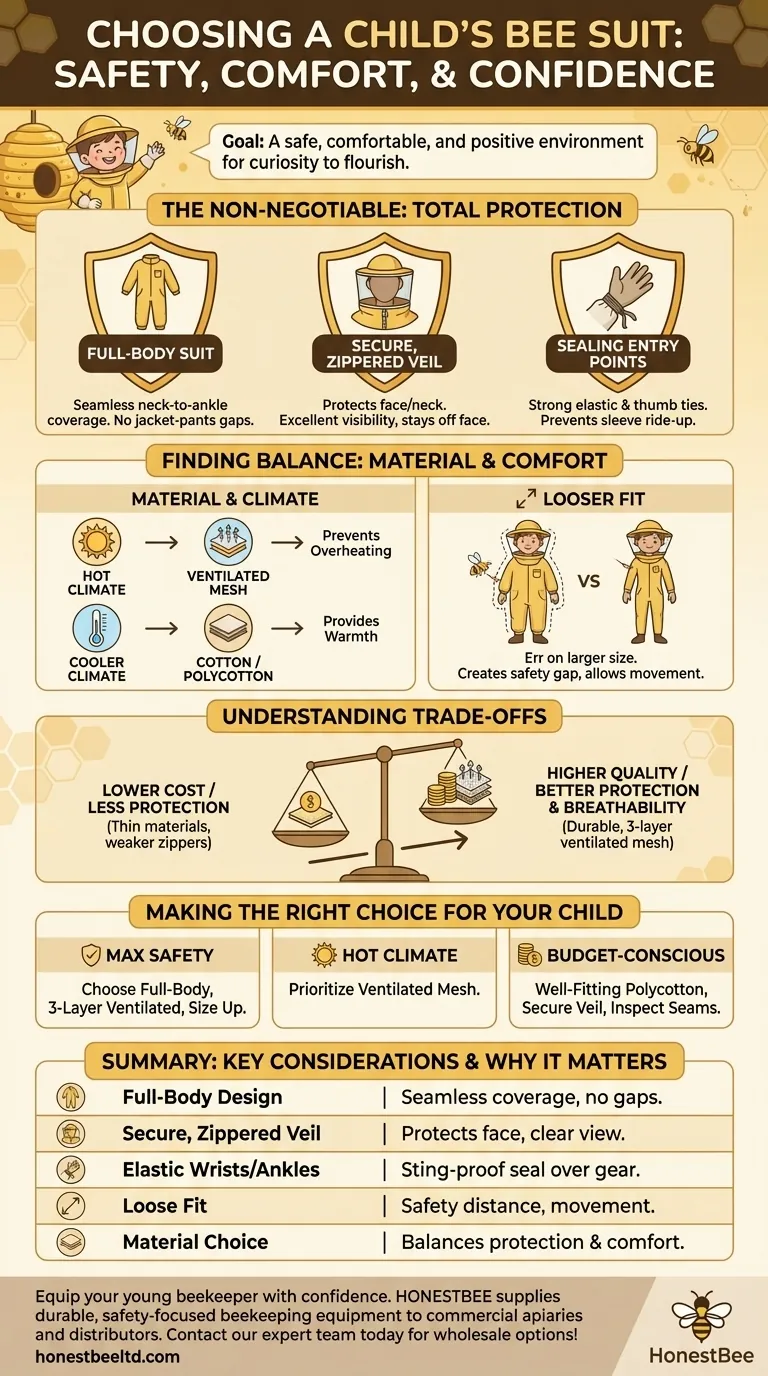When choosing a bee suit for a child, the most critical considerations are ensuring a loose fit for safety, selecting a full-body design for complete coverage, and verifying that the veil is securely attached. These factors work together to provide a sting-proof barrier that is also comfortable for the child.
Choosing a bee suit for a child goes beyond simply preventing stings. The goal is to select gear that creates a safe, comfortable, and positive environment, allowing a child's curiosity about beekeeping to flourish without fear.

The Non-Negotiable: Prioritizing Total Protection
A child's sense of safety is paramount when they are near a hive. Their gear is the foundation of that confidence, and it must be comprehensive and properly secured.
Why a Full Suit is the Standard
While experienced adults may opt for a simple jacket, a full-body suit is the recommended choice for a child. It provides seamless protection from neck to ankle, eliminating the potential for a gap to open up between a jacket and pants.
The Critical Role of the Veil
The face and neck are sensitive areas, making the veil the most important component. Look for a detachable fencing veil that attaches to the suit with a robust zipper. This design offers excellent visibility and keeps the mesh away from the child's face.
Sealing the Entry Points
Bees can exploit the smallest gaps. A quality suit must have strong elastic at the wrists and ankles to create a snug seal over gloves and boots. Features like thumb ties are also highly valuable, as they prevent sleeves from riding up when putting on gloves.
Finding the Right Balance: Material and Comfort
A suit is only effective if a child is willing to wear it. Comfort, therefore, is just as important as protection, and it is largely determined by the material and fit.
Understanding Material Types
Most children's suits are made of lightweight cotton or a polycotton blend, which offer a good balance of breathability and protection. For superior sting prevention and airflow, consider a 3-layer ventilated mesh suit.
Matching Material to Your Climate
The local climate should guide your material choice. In hotter regions, a ventilated suit is ideal to prevent overheating. In cooler climates, a thicker cotton or polycotton suit will provide more warmth.
The Importance of a Looser Fit
Always err on the side of a larger size. If your child is between sizes, order one size up. A looser fit is safer because it creates more space between the fabric and the skin, making it much harder for a bee's stinger to reach. It also allows for greater freedom of movement.
Understanding the Trade-offs
Choosing the right suit involves balancing key factors. Being aware of these trade-offs will help you make a more informed decision.
Cost vs. Quality
While budget is a factor, be cautious with extremely low-priced suits. Products costing less than $100 may use thinner materials, weaker zippers, or less durable mesh. Investing a bit more in a suit from a reputable supplier often translates to better protection and a longer lifespan.
Protection vs. Breathability
There is an inherent trade-off between sting resistance and comfort. Thicker, multi-layer materials offer the best protection but can be warm. Lighter cotton suits are more breathable but may offer less defense. Ventilated mesh suits are the modern solution to this problem, but they typically come at a higher price point.
Making the Right Choice for Your Child
Use your primary goal to guide your final decision on the best bee suit for your young beekeeper.
- If your primary focus is maximum safety and peace of mind: Choose a full-body, 3-layer ventilated suit and ensure you size up for a loose fit.
- If your child will be in a hot climate: Prioritize a ventilated mesh suit to prevent overheating and ensure the experience remains comfortable and enjoyable.
- If you are on a budget but still need reliable protection: Opt for a well-fitting polycotton suit with a securely zippered veil, and carefully inspect the seams and elastic closures.
A well-chosen suit transforms a potentially intimidating experience into a safe and fascinating adventure.
Summary Table:
| Key Consideration | Why It Matters |
|---|---|
| Full-Body Design | Seamless protection from neck to ankle, eliminating gaps. |
| Secure, Zippered Veil | Protects sensitive face/neck area and offers clear visibility. |
| Elastic Wrists/Ankles | Creates a sting-proof seal over gloves and boots. |
| Loose Fit (Size Up) | Increases safety by distancing fabric from skin and allows movement. |
| Material Choice | Balances protection and comfort (e.g., ventilated mesh for hot climates). |
Equip your young beekeeper with confidence and the right gear. At HONESTBEE, we supply durable, safety-focused beekeeping supplies and equipment to commercial apiaries and distributors. Our wholesale-focused operations ensure you get reliable, high-quality children's bee suits that prioritize protection and comfort. Let's discuss the best options for your needs—contact our expert team today to get started!
Visual Guide

Related Products
- Professional Beekeeping Suit for Kids and Girls Childrens Bee Keeper Suit
- White Beekeeping Protective Suit and Hat with Fencing Veil for Beekeepers
- Cotton Beekeeping Suit and Round Hat with Veil Bee Keeper Protective Gear
- Heavy Duty Cowboy Beekeeper Hat with Visibility Veil Outdoor Professional Beekeeping Protective Gear
- Beekeeper Cowboy Hat and Veil for Beekeeping
People Also Ask
- What is the purpose of a bee suit in beekeeping? Essential Protection for Safe Hive Management
- What are the key components of a bee suit? Build a Complete Bee-Proof Barrier for Your Apiary
- Is a bee suit necessary for beekeeping? Essential Gear for Beginner & Pro Beekeepers
- What should I consider when choosing a bee suit? Key Features for Maximum Protection & Comfort
- Can children wear bee suits? Equip Kids for Safe & Educational Beekeeping



















